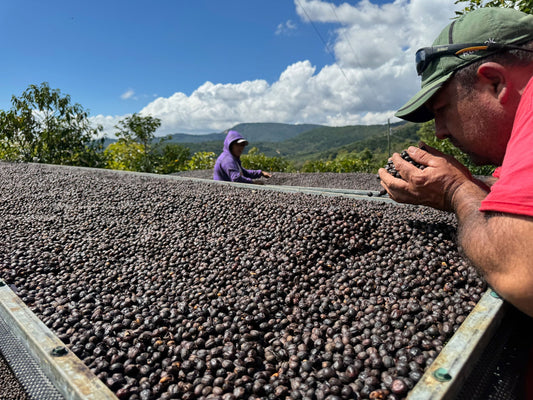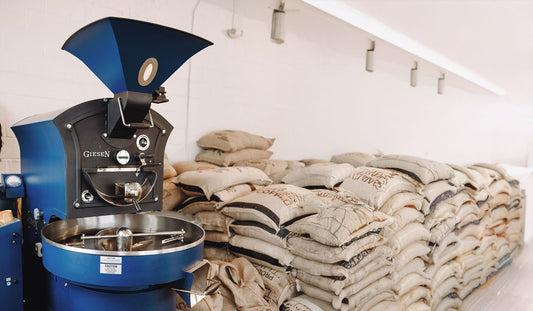When we talk about the flavor of coffee, we’re talking about the expression of the environment where the coffee was grown—its terroir. The geography, climate, altitude, and even the way the beans are processed after harvest all influence the final taste. Let’s dive into how these factors shape the flavor profiles of coffees from different regions.
Coffee Regions and Flavors
Most coffee flavor profiles are generalizations. It’s important to remember that the characteristics of specialty coffee beans – even within the same geographic region – can differ. Farmers and producers may have different harvesting and processing methods. Plus, their access to water may vary. Other factors that may influence flavor include:
- Climate – Temperature, rainfall, and humidity levels influence bean development and flavor complexity. Warmer, humid climates tend to produce sweeter beans, while cooler, high-altitude regions can enhance acidity and fruity notes.
- Soil Composition – Volcanic soils, rich in minerals like potassium and magnesium, are known for producing coffees with more pronounced sweetness, body, and acidity. Soil types vary by region, giving each coffee its own unique character.
- Altitude – Coffee grown at higher altitudes matures more slowly, which results in beans with more nuanced acidity and brighter fruity or floral notes. Lower-altitude coffees tend to have a fuller body and smoother, earthy flavors.

African Coffee Flavor Profiles
African coffees are often known for their high acidity, complex fruity notes, and floral aromas. The region’s high altitudes, proximity to the equator, and rich volcanic soils create ideal growing conditions for nuanced flavors.
Ethiopia
Ethiopian beans are often processed naturally (sun-dried with the cherry intact), resulting in bright, fruity flavors like blueberry and stone fruit, as well as floral and jasmine-like aromas. Some regions (e.g., Yirgacheffe) are known for their tea-like body and delicate acidity.
Kenya
Grown at high altitudes (often above 1,500 meters), Kenyan coffees are typically known for their bright acidity and juicy, fruity flavors such as black currant, grapefruit, and citrus. These beans are often full-bodied with complex layers of sweetness.
Tanzania
Coffees from Tanzania are known for their bright acidity and berry-like flavors (especially blackberry and blueberry). Grown in volcanic soil around Mount Kilimanjaro, Tanzanian beans often resemble Kenyan coffee but are slightly lighter-bodied.
Zambia
Known for producing juicy, fruity coffees with notes of citrus and berries. The ancient volcanic soils of Zambia’s highlands, combined with moderate altitudes, give Zambian coffee a rounded sweetness with moderate acidity.
Central and South American Coffee Flavor Profiles

Coffees from Central and South America are typically well-balanced, offering mild-to-moderate acidity, chocolatey, nutty, and citrusy notes. The diversity of altitudes and climates within this region creates a wide range of flavors.
Brazil
Lower altitude farms and overall tropical climate contribute to beans that are often bold, smooth, and full-bodied, much like our Stout coffee. Brazilian coffees can have chocolate, nutty, and caramel notes, with a lower acidity compared to other regions. These beans are often used in espresso blends due to their rich body.
Colombia
Colombian coffees are known for their balanced flavor profiles, with bright acidity, citrus notes, and a smooth, nutty finish. The country’s varied microclimates (from high-altitude mountains to tropical lowlands) contribute to the wide range of complex flavors.
El Salvador
High-altitude coffees from El Salvador have a mild-to-moderate acidity and flavor notes of chocolate, brown sugar, and caramel. The volcanic soils contribute to the richness and sweetness of these beans.
Nicaragua
Nicaraguan coffee is known for being well-balanced, with citrus and chocolate notes. The country’s tropical climate and high altitudes produce beans that are often described as smooth with a medium body and moderate acidity.
Costa Rica
Coffee from Costa Rica is prized for its bright acidity and clean, balanced flavor profiles. Grown in high-altitude regions (over 1,200 meters), Costa Rican beans often have citrus, red berry, and honey notes. These coffees are also known for their clarity and brightness.
Mexico
Mexican coffees are typically light-bodied, with flavors that are sweet, nutty, and slightly earthy. The high-altitude regions like Chiapas produce coffees with a subtle acidity, often with chocolate and almond undertones.
Asian Coffee Flavor Profiles
Asian coffees often have earthy, spicy, and smoky characteristics, with a full-bodied, syrupy mouthfeel. These flavors are influenced by the region’s humid, tropical climates and unique soil compositions.
Indonesia (Sumatra, Java)
Sumatran coffees are known for their full body and earthy, herbaceous flavors, often with notes of spice and tobacco. The wet-hulling process used in Sumatra gives the beans a distinctive heavy body and low acidity, with flavors of dark chocolate, earth, and sweet spices. Java coffees tend to be slightly lighter with chocolatey and nutty undertones.
Vietnam
Vietnam is one of the largest producers of Robusta coffee, which is typically bold, earthy, and has a strong, bitter finish. These coffees are often used in espresso blends or traditional Vietnamese coffee (served with sweetened condensed milk). Some Arabica is also grown at higher elevations, offering more delicate flavors than Robusta.
Papua New Guinea
Coffees from Papua New Guinea have a medium body with a bright acidity and fruity, floral notes. The diverse microclimates and volcanic soils contribute to the sweet, juicy flavors of stone fruits, with a hint of spice.
Other Notable Regions in the Coffee Belt
Yemen
As one of the oldest coffee-growing regions, Yemeni coffee has a unique, wine-like flavor with spices, dried fruit, and chocolate notes. The arid climate and ancient, traditional farming methods give Yemeni beans a distinctively complex profile.
Hawaii (Kona)
Kona coffee from Hawaii’s Big Island is prized for its smooth, mild flavor with hints of sweet nuts and fruit. The rich volcanic soils, combined with the island’s tropical climate, make for beans with balanced acidity and full body.
Exploring Coffee Flavors By Region

The coffee flavor profiles above only cover a portion of actual growing regions around the world. Countless other countries across Africa and Central and South America grow coffee. We invite you to explore coffee regions and flavors for the opportunity to experience the diversity each community has to offer.





